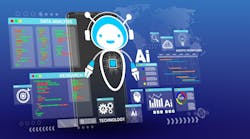Manufacturing Takes a Trip to the Metaverse
Justin Bieber, Travis Scott, and Ariana Grande have all had concerts in the metaverse. “Break the Bars” was the first movie to premier in the immersive virtual world. And last December, digital artist Pak’s work, “The Merge,” sold for US$ 91.8 million.
While most people know of the metaverse through gaming and entertainment, it is relevant to nearly every mainstream business. An estimate by Bloomberg Research says the metaverse market could grow at a compound annual growth rate of 13.1%, to go from $479 billion in 2020 to more than $783 billion in 2024.
This post looks at the potential of the metaverse in manufacturing by highlighting some early but promising implementations in the industry.
Collaborate and Create in a Virtual Space
Like many recent discussions, this one also starts with the pandemic. Even though COVID-19 is receding, many people are opting to work remotely. In automotive manufacturing, the metaverse can help hybrid working teams collaborate on new product development. Ford’s Design Studio employs a virtual-reality-based platform where teams of engineers, designers and product developers located all over the world collaborate in a virtual space to create products. Remotely working teams visualize, render and experiment with 3D models in real-time.
Click Before You Brick
Another use case is redesigning workplace facilities for post-pandemic times. Some companies are redoing their layouts to suit a flatter organization, flexible seating, agility in work and smaller in-person attendance. They can design their spaces virtually in the metaverse before building them physically. In fact, manufacturers can design entire greenfield factories in the metaverse, visualizing not just the physical placement of machines but even the movement of personnel, autonomous vehicles, and robots—and their mutual interactions—in dynamic 3D space.
Further, they can iteratively test the design for ergonomic efficiency and safety in human-machine collaboration through a physics-based simulation, before laying a single brick. For example, collision between humans and machines (like robots) can be avoided by simulating their movement both at one workstation and across the workspace. Movements can be minimized by optimizing the location of equipment, tools and material, ultimately leading to productivity. Microsoft CEO Satya Nadella calls it the “enterprise metaverse,” a new layer of infrastructure stack for hybrid workplaces.
Boosting Training Delivery
Training is yet another area that can benefit greatly from the metaverse. With manufacturing systems and products becoming increasingly complex, involving both mechanical and digital technologies, enterprises need to train and retrain their workforce.
Chemical company Linde has created its Virtual Academy to train its new recruits. Operators in the industrial gas sector in which Linde operates need to work on complex procedures. A wrong step can be costly. Virtual training of these procedures resulted in cost savings—in addition to four times more focus and faster learning than classrooms and three times more confidence in application of the skills learned.
Improving Decision-Making
Higher up the value chain, the metaverse finds application in digital twins—detailed virtual replicas of physical products. A digital twin is a highly analytical tool that uses mathematical models to simulate the working of a product. It also takes real-time data feeds from IoT devices and sensors to make predictions. But the full power of a digital twin is realized only when it creates “what if” analyses and simulations to help manufacturing personnel make better decisions. That being said, human beings will still need to monitor the behavior of a digital twin to ensure nothing important has been missed. The metaverse facilitates this by visualizing it to aid decision making. General Electric, for example, uses augmented reality for humans to look into a gas turbine’s digital twin, without touching any parts, to deliver the desired electrical power output at the lowest possible fuel consumption, with wind turbines that collectively optimize the production of electricity from wind farms. A digital twin helps conduct what-if analyses to proactively predict the performance during situations such as the change of fuel used, the impact of fluctuating load from the power grid and replacement of a critical part such as a fuel nozzle with an upgraded version etc.Providing Immersive Experiences
In addition to deploying use cases on the enterprise side, manufacturers can tap the metaverse for their consumers. Again, the automotive industry leads by allowing prospective buyers to configure cars to their taste with the metaverse to get a “feel” for the product. Hyundai Mobility Adventure is Hyundai’s metaverse space for its customers to experience the company’s mobility offerings with customized avatars. On the enterprise side, with leaders like Microsoft, Google, and Apple set to make big announcements, metaverse will see large scale adoption. Microsoft’s plans are to integrate its mixed reality tool Mesh with the productivity and collaboration platform Teams. A mixed reality headset could be the next big product launch for Apple and Google. The growing ubiquity of IoT provides real time feedback for complex systems and products to make metaverse truly immersive, showing the true picture out in the physical world.By visualizing, modeling, simulating and enabling “experiences”, the metaverse helps manufacturers get things right the first time—and thereby minimizes expensive rework. The technology brings down the related cost, time to value and risk of faulty decision-making.
Jasmeet Singh is executive vice president and global head of manufacturing, Infosys.




